|
If you've visited
any
blogs
in the last year, you've read about people
who've bought spinning wheels. Their first, a new
one that does something that they other one[s] they
own don't do. But it's definitely not an inexpensive
purchase, and probably not an impulse buy.
What IS that like,
to get something so old-yet-new? There
is all sorts of anticipation and excitement
and maybe even a little dread [for the
new spinner like me that's just shelled
out a few hundred dollars -- can they
actually make this thing spin yarn?].
Because I'm writing this column
for Knitty, I gave myself permission to get
a wheel. The non-columnist Amy would never buy
something like this so early in taking up a
new craft, but I told myself it's for the benefit
of the readers, really. I am also a certified
gear ho™, and the opportunity to add something
cool and functional to my collection was the
final push over the fibery cliff.
So, I went on a search.
What spinning wheel would suit my fussy
aesthetic sense, fit in my tiny house,
go with me so people could teach me
how to use it and work well
for the non-woolly fibers I want to
spin?
I put up a call for suggestions
on my blog, and got amazing, diverse and detailed
answers. Like shoes or cars, the choice of a
spinning wheel is intensely personal. How do
you want to sit in front of it? Do you care
how it looks? Do you want it tall or short?
Basic, or with lots of extras you can buy later?
Embellished and decorated or very simple?
My requirements were as follows:
- small/compact/portable/reasonably light
- modern and unfussy in design
- as flexible as possible in terms of
ratios
- as affordable as possible
I approached several wheel
companies with likely candidates, including
Majacraft, Schacht, Louet and Ashford. And after
much consideration, conversation with spinning
friends and the gut feeling I had, I decided
the Ashford Joy Double Treadle was for me. Aesthetically,
it won hands down. It's a beautiful anachronism
-- modern, highly engineered to do what it does,
yet still reminiscent of the antique wheels
I've seen and admired. It was also the most
affordable for me of the three brands, and that
did have an influence on my decision.
But did I test drive it before
I ordered? No. Surprisingly, there are few places,
even in the big city I live in, where wheels
are assembled and available for test drives.
If I'd been smart and patient [the latter has
never been one of my virtues], I'd have waited
to order till Rhinebeck where every possible
wheel was available for testing. But not everyone
can get to a fiber festival to test drive a
wheel. Sometimes all you have to go on are specs
and recommendations from your friends. So that's
what I did.
I
placed the order for the basic wheel with the
carry bag and waited for the Vancouver dock strike
to end so the cargo that was stuck in port could be
unloaded. Bless them, they did settle. So Treenway
shipped my first wheel to me.
I thought it might be neat
to chronicle what it's like to unpack and assemble
a brand-new wheel, so here, for your amusement,
are the pictures of that day.
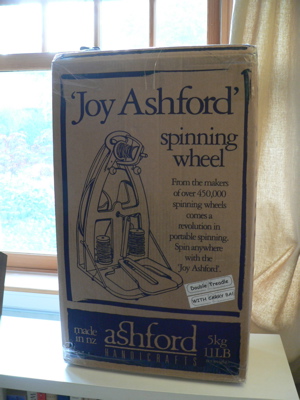
The big box, taped and sealed, ready to be cracked
open.
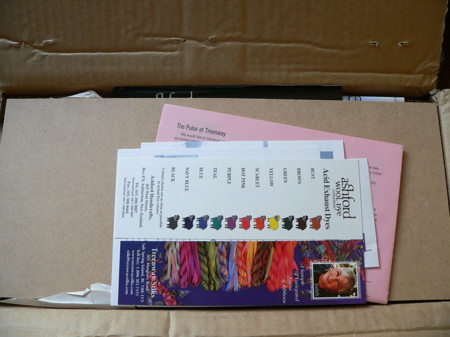
Open the top and inside, cardboard and lots
of tantalizing paperwork.
The top flyer is for the Ashford line of dyes.
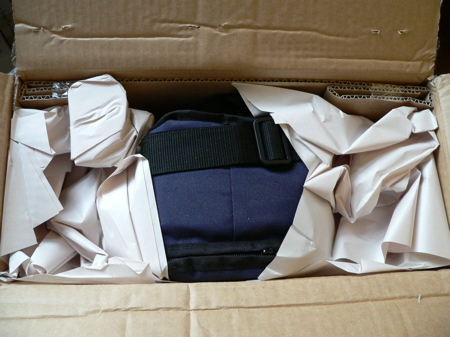
Look! The top of the carrying case.
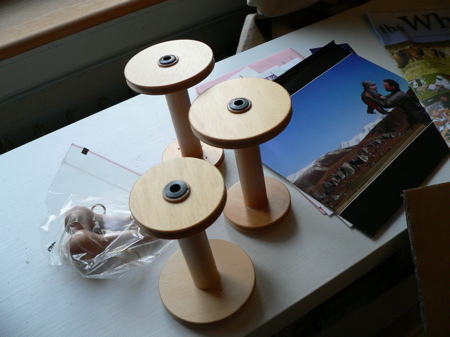
Three bobbins that come standard with the Joy.
The orifice hook and tension knob are in the
baggie on the left.
On the right, sheepy postcards of New Zealand
to taunt you.

The carrying case -- well made and sits comfortably
on your shoulder.
What's inside?
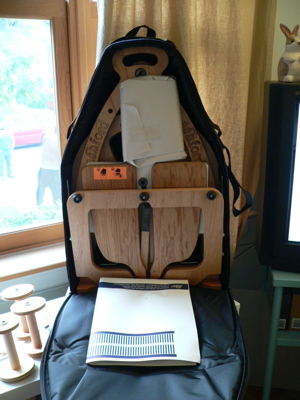
There she be. My new wheel. See how well it
fits in the carrying case?
I'm a sucker for good design.
The treadles are folded up and the flyer is
not attached --
that's it wrapped in the white paper.
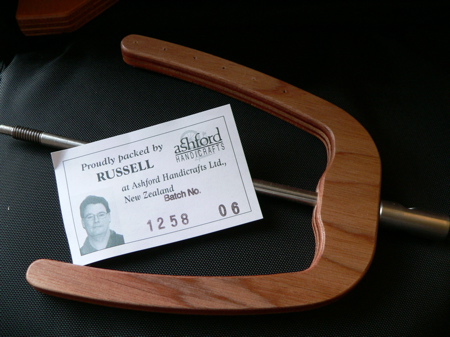
Russell proudly packed my wheel.
Hi, Russell!
[This is the flyer as it comes -- no hooks on
it yet.]

Clear instructions on what I've gotta do, with
illustrations. Love that.
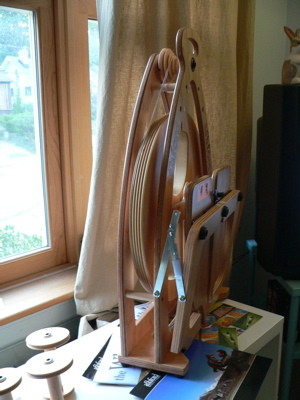
My first real look at the Joy.
It's made of laminated and varnished high-quality
plywood and really is lovely.
Looks like a cathedral to me. Treadles are still
folded up.
Note the built-in handle for carrying at the
top.
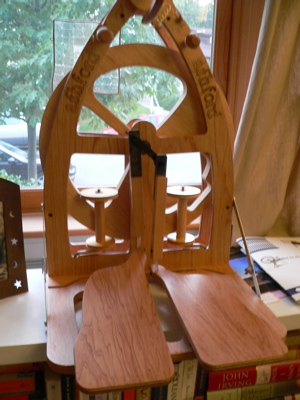
There she is. The treadles fold down easily
and you simply slide the vertical
bar attached to the right pedal onto the mechanism
once it's open.
The bobbins, which are stored on rotating rods,
slip into
the openings of the wheel itself for storage.
For use, the bobbins rotate out, away from the
wheel
and you have your own built-in lazy kate for
plying.
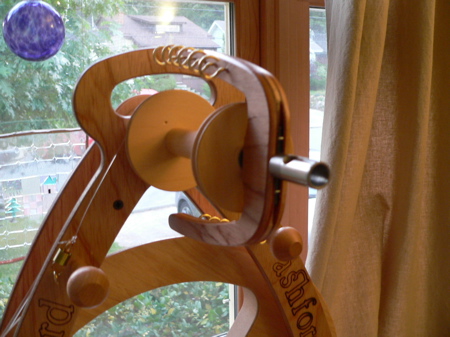
I screwed in each eyehook as instructed [holes
were pre-drilled so placement was easy]
and screwed the flyer onto the wheel. The orifice
hook sits in a hole on the left.
The tension knob is on the right, and the works are
easily assembled.
So there. My
wheel. Not as expensive as a car, but certainly
not a spindle, either. The double treadle design
is great for my occasionally dodgy knees, and
the height is perfect for me. It is portable,
as promised. But can I spin on it?
See you next
issue.
|

